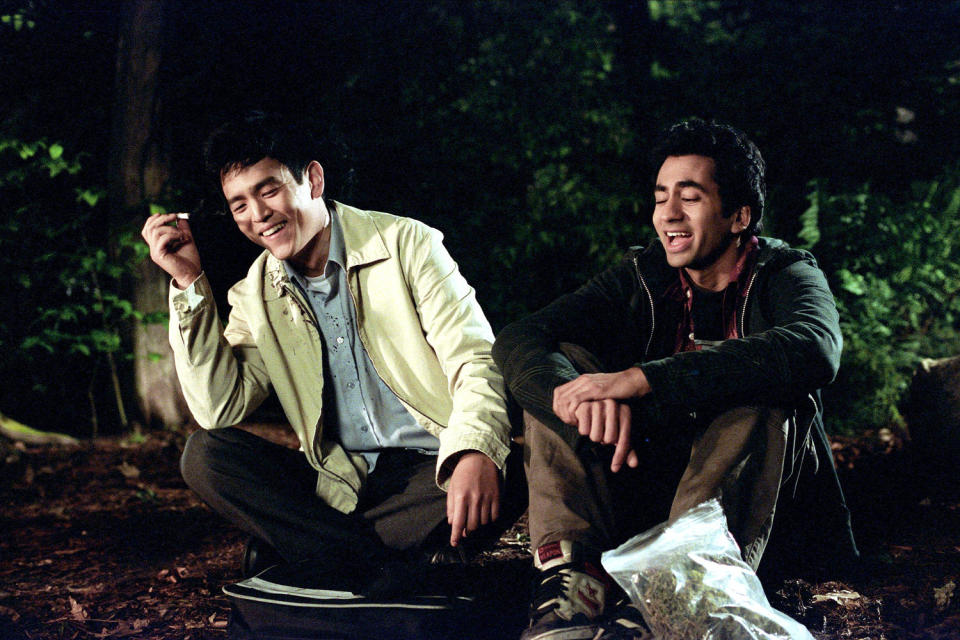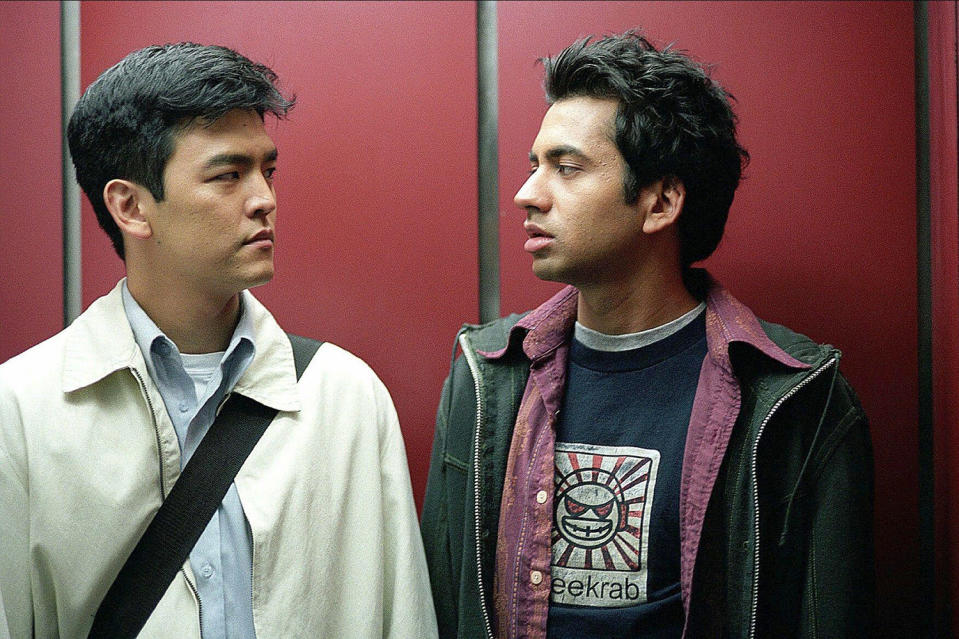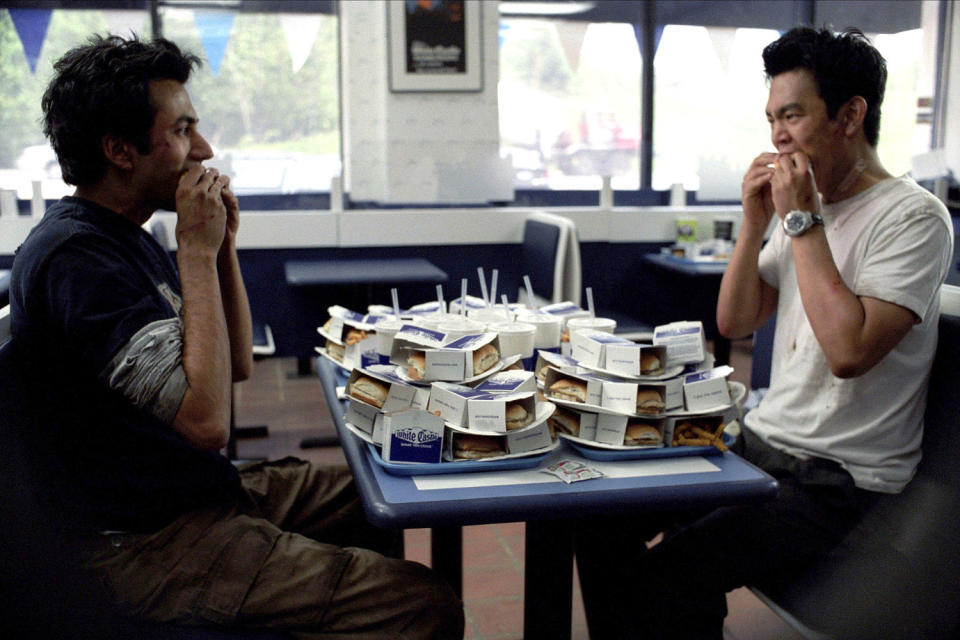Asian Americans reflect on how 'Harold & Kumar' helped weed out stereotypes
- Oops!Something went wrong.Please try again later.
This year marks the 20th anniversary of stoner comedy “Harold & Kumar Go to White Castle” lighting up theaters across the country, but with two Asian Americans at the center of the munchie-fueled adventure, its impression on many people of Asian descent never faded.
The blockbuster hit, released in July 2004, is one of the only mainstream movies of its decade to star two Asian American leads, John Cho and Kal Penn. For some, the movie validated the experiences of stoners, outcasts, and anyone who didn’t fit the narrow, nerdy trope that dominated perceptions of Asian Americans at the time. Others say the comedy widened ideas of what Asian Americans could be.
As stoners across the country celebrate 4/20 on Saturday, many Asian Americans among them are reflecting on the stereotypes the film blitzed and the trail it blazed.

“My friends looked like Harold and Kumar. We acted like Harold and Kumar,” Cindy Trinh, a New York City-based photographer, said of the characters played by Cho and Penn, respectively. “That left an impression on me forever. I will always remember Harold and Kumar.”
Set in New Jersey, the film follows one rowdy weekend between friends and roommates Harold, a stressed-out investment banker, and Kumar, an unmotivated genius whose only passion is partying. Harold is being bullied into doing the work of his white co-workers, who claim that “Asian guys love crunching numbers,” and Kumar attempts to buck his doctor father’s demanding expectations by intentionally throwing a medical school interview. The pair get high together and, in their hazy state, become fixated on the sliders they see in a White Castle television ad. The friends set off on a quest to fulfill their cravings — which include a trip to Princeton to find more weed, a hitchhiking Neil Patrick Harris, and an encounter with a cheetah on the loose — and, in turn, end up on a journey of self-discovery.
Trinh, who uses they/them pronouns, explained that they were in college and around the age of the film’s stars when the movie was released. Trinh, who’s from California, still remembers gathering a group of their Asian friends from school, taking a couple puffs together and going to the theater.
“As someone who was very much a stoner California Asian, it was hard. Our society and our families kind of makes us feel like we’re losers,” Trinh said. “[The film] shattered this stereotype that I had to constantly be this top student, this ‘excellent citizen.’”

Trinh said that Kumar’s backstory in particular mirrored their own early experiences of feeling pressured to go to law school. It also showed them that Asian Americans all the way in New Jersey could be going through the same struggle, they said.
“Learning that, ‘Wow, there’s other Asians that might be like me, even on the other side of the country!” Trinh, 40, said. “I remember that going through my mind.”
Anthony Ocampo, a sociology professor at California State Polytechnic University, Pomona, said that in the early aughts, major studio films barely featured any Asian Americans in speaking roles. “Harold & Kumar,” he said, was huge.
“The only films where Asians got more than a minute of screen time or where Asians spoke actual words were martial arts movies like ‘Crouching Tiger, Hidden Dragon’ or ‘Rush Hour’ or ‘Romeo Must Die,’” Ocampo said.
Ocampo said that for many Asian American men, Harold’s ability to win over his crush Maria, was a significant arc, particularly given the rarity of romantic roles given to them. But the most compelling part of the film, in his opinion, was the unserious nature of the characters’ adventure. Many Asian American-centered stories are anchored in topics like language barriers and intergenerational differences, Ocampo said. It’s all important, but the group deserves comedy, too.
“‘Harold & Kumar’ is a movie that shows that Asian Americans get to be hot messes, too,” Ocampo said. “That’s important because being a hot mess is part of life, part of being a human … and so Asian Americans should have the same chance as any other group to showcase every aspect of their humanity on the big screen.”

Christine Hoang, a screenwriter based in Austin, Texas, said she also had distinct memories of watching the film. Hoang, who’s in her 40s, said she conformed to her parents’ pressures for most of her life, going to law school and eventually becoming a lawyer. Hoang said she had just taken the bar exam when the film debuted.
“I grew up in the ‘Just Say No’ era with very strict Catholic parents. You go to school and your refugee parents are pushing you to be successful, because otherwise, what are their sacrifices for?” Hoang said. “But when I saw it, I was like, ‘Wow, we had choices all this time? I could go on a trip and ride a tiger? ... I didn’t know people could take paths other than what was prescribed to you by your parents.”
Hoang said it was eye-opening to see Asian Americans on screen act impulsively and selfishly without calculating their parents’ expectations in their every move — a privilege she felt was only available to white people. While it ultimately took years for her to pursue her true dreams of becoming a screenwriter, Hoang said the film planted a small seed.
Tony DelaRosa, an Asian American race scholar and the author of “Teaching the Invisible Race,” also noted that there are unmistakably racial elements throughout the film. Not only do the stoner characters themselves subvert the squeaky-clean Asian American trope, Harold, for example, threatens to get his ignorant co-workers fired for exploiting him. And Kumar ends up realizing he does, in fact, want to follow in his father’s footsteps, but he has been afraid of conforming to stereotypes. The film also calls out common forms of racism toward Asian Americans, like one scene in which a cop tries to roast the spelling of Kumar’s name.
With such groundbreaking elements, some believe the film should be touted as a historic example of Asian American representation. But DelaRosa suspects it’s likely that other Asian Americans are hesitant to do so, since the film doesn’t conform to some perhaps internalized “model minority” expectations. The Asian American movement, he said with a laugh, is “definitely not glamorizing a stoner film.”
But he also underscored that the film isn’t perfect. He said there are scenes that have been criticized as homophobic and others as objectifying women. It’s time, he said, to demand more from films.
“It was a great starting place to talk about race and definitely not the end,” he said.
This article was originally published on NBCNews.com

